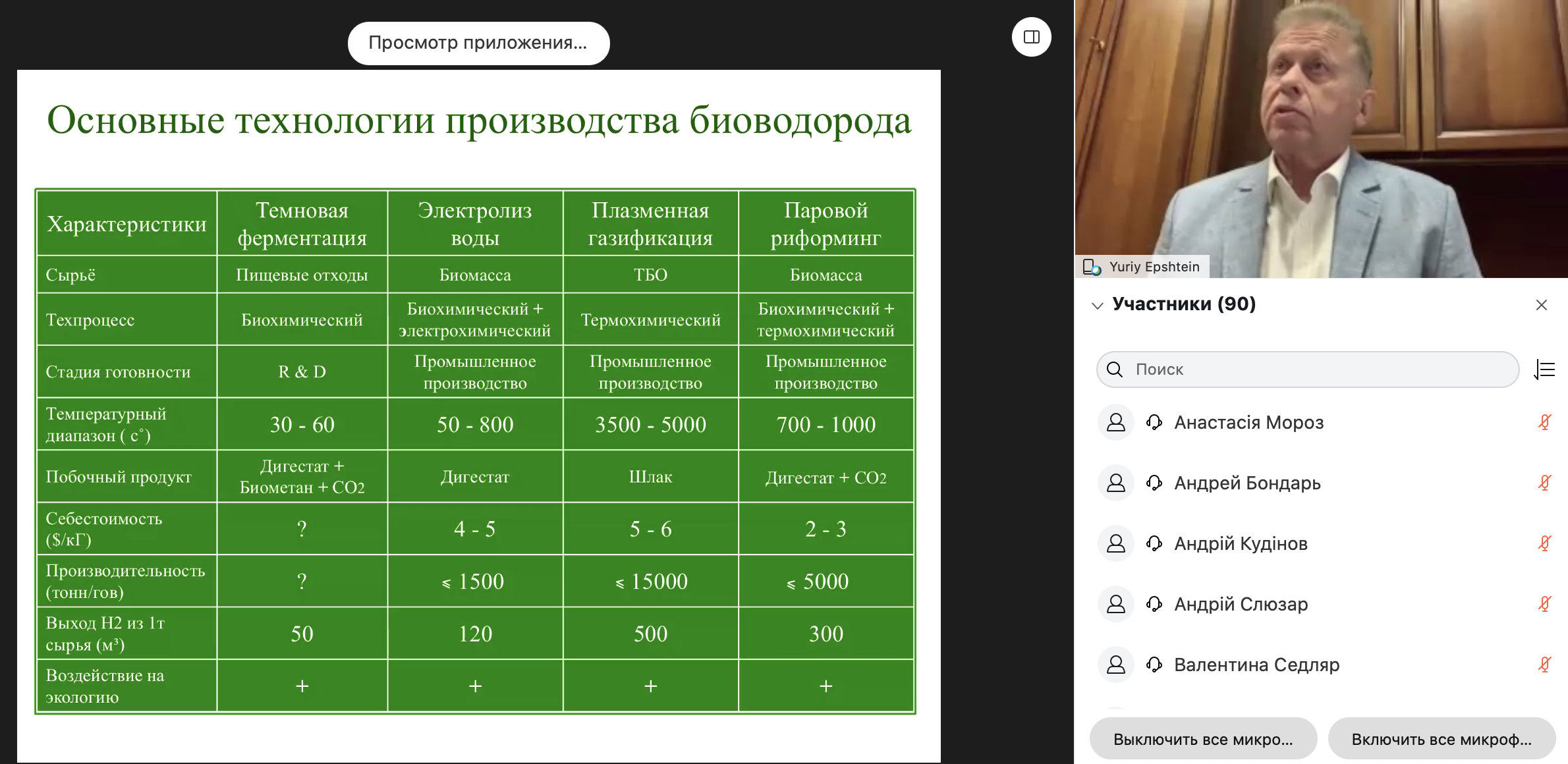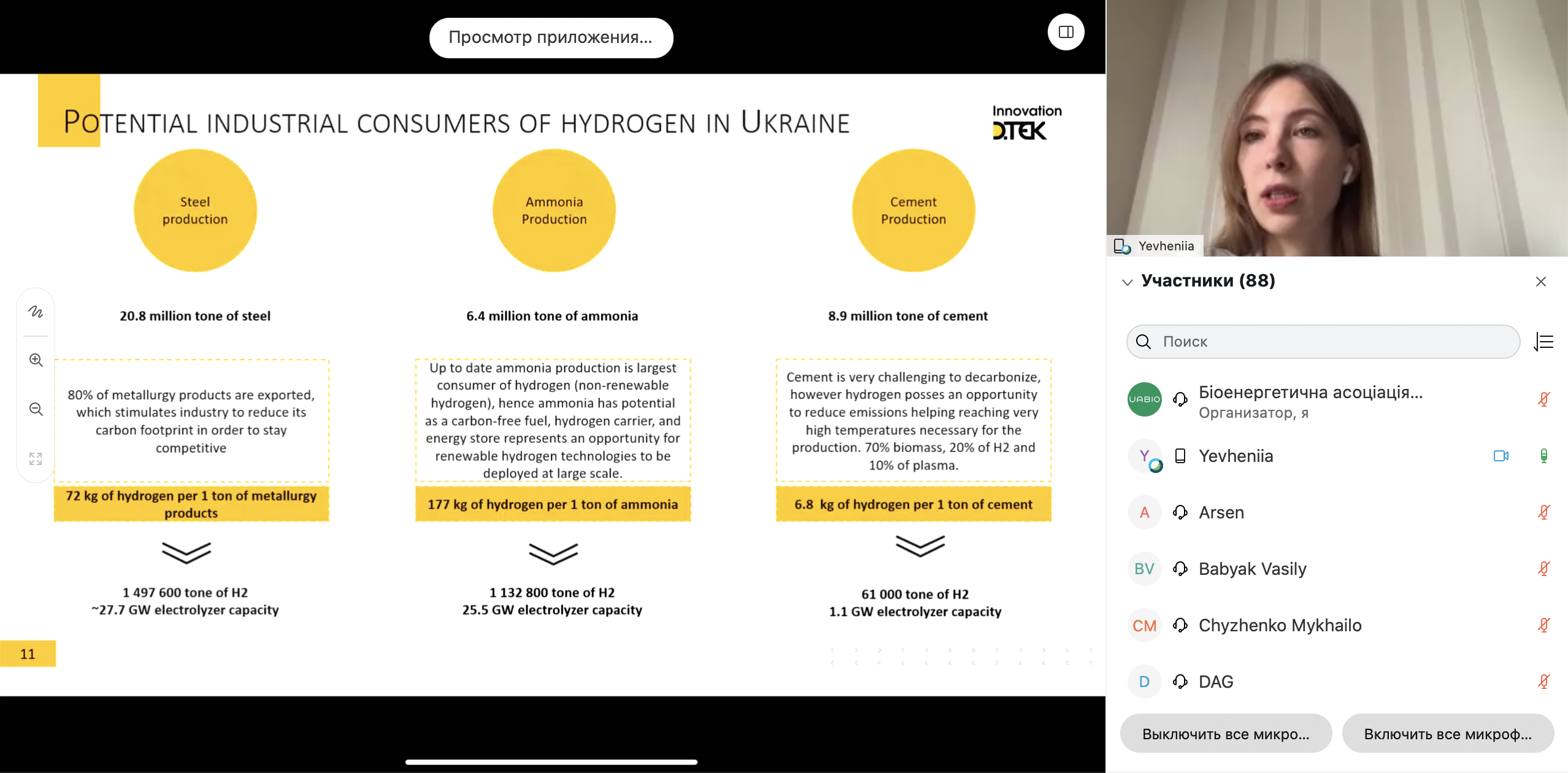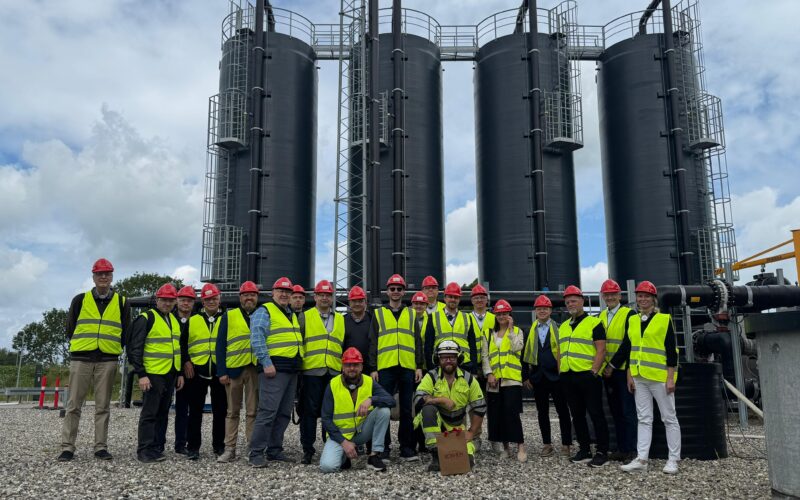Prospects for the production and consumption of renewable gases in Ukraine — the results and materials of the online seminar
On September 29, an online seminar “Prospects for the production and consumption of renewable gases in Ukraine” was held.
More than 100 specialists in the field of bioenergy, including representatives of business, agricultural companies, associations, legislative and executive authorities, public organizations in energy, scientists, financial institutions, investors and entrepreneurs interested in renewable gas production and consumption took part in the event. More than 1,300 people joined the online translation.
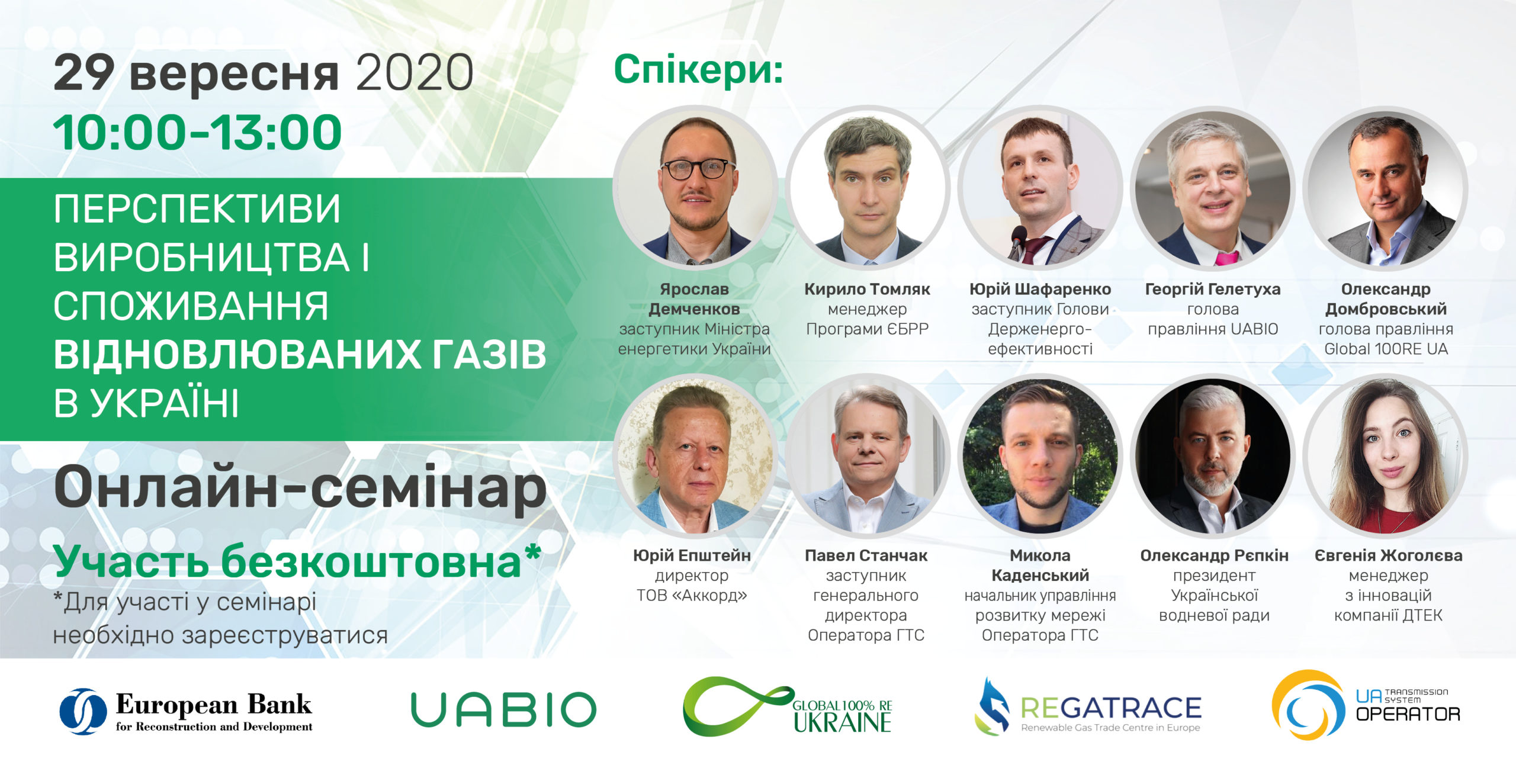
Speakers: Yaroslav Demchenkov – Deputy Minister of Energy of Ukraine, Kyrylo Tomliak – EBRD Program Manager, Yurii Shafarenko – Deputy Chairman of the State Agency on Energy Efficiency and Energy Saving of Ukraine, Georgii Geletukha – Chairman of the Board of UABIO, Oleksandr Dombrovskyi – Chairman of the Board of Civic Union Global 100 RE Ukraine, president of the MHP Eco Energy, Yurii Epstein – Director of Accord LLC, Pavel Stanchak – Deputy General Director of LLC “Operator of the GTS of Ukraine”, Mykola Kadenskyi – Head of the Network Development Department of LLC “Operator of the GTS of Ukraine”, Oleksandr Repkin – President of Energy Association «Ukrainian Hydrogen Council», Yevheniia Zhoholieva – DTEK’s innovation manager.
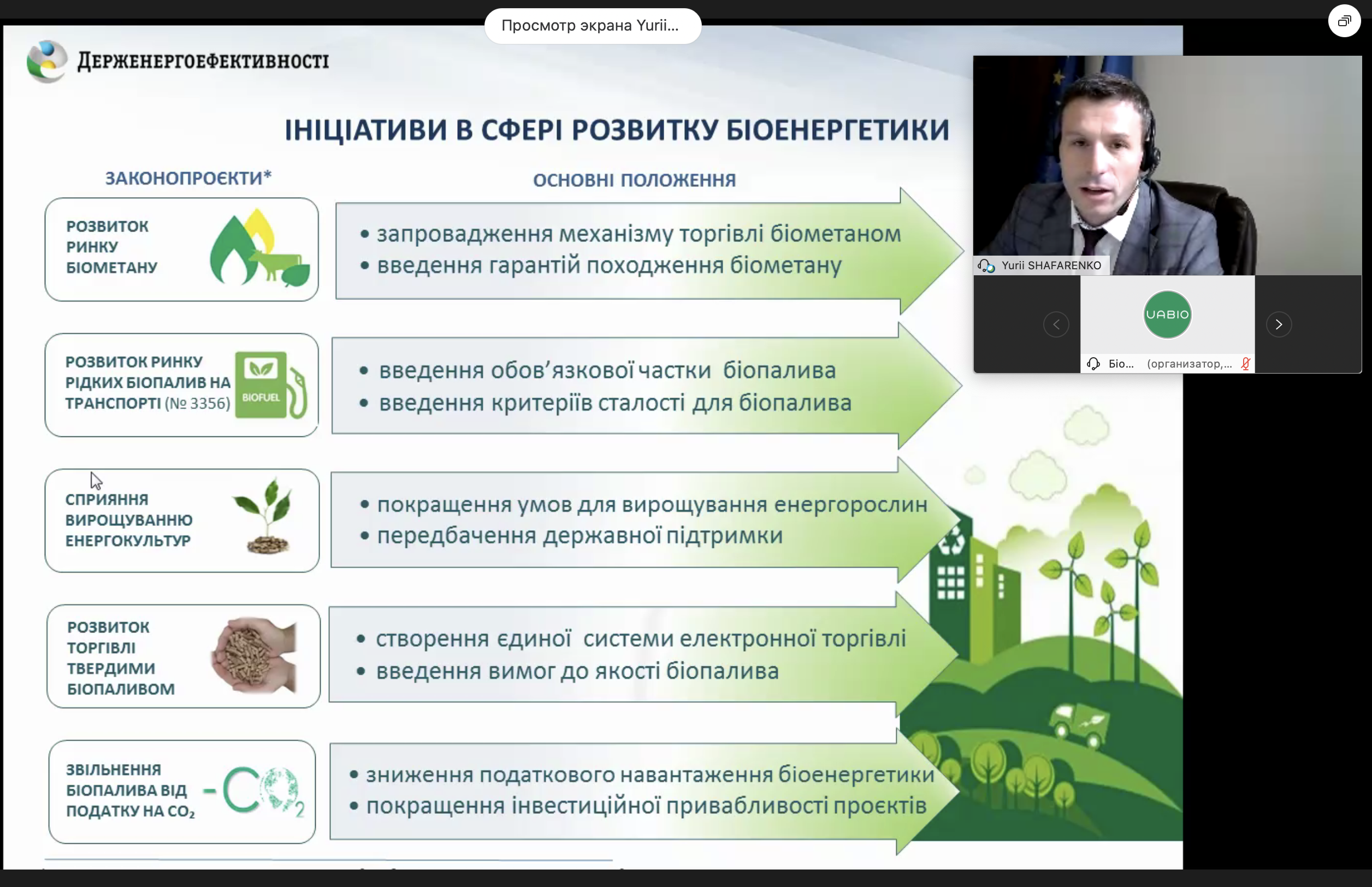
Organizers: Bioenergy Association of Ukraine, European Bank for Reconstruction and Development, Project REGATRACE «REnewable GAs TRAde Centre in Europe», Civic Union «GLOBAL 100% RE UKRAINE», Gas Transmission System Operator of Ukraine LCC.
The online seminar will be conducted through the Horizon 2020 project REGATRACE “REnewable GAs TRAde Centre in Europe” and the EBRD and GEF Programme “Ukraine: Sustainable Bioenergy Value Chain Innovations”.
Speakers quotes
- Yaroslav Demchenkov, Deputy Minister of Energy of Ukraine: «Ukraine must promptly review its policy and adapt it to new climate and energy challenges. Very important not to lose the trend of sustainable development and economic competitiveness in the coming years. We strive to make the energy system safe, competitive and stable in according to the European green course. Today, natural gas ranks second in the commodity structure of Ukraine’s imports after oil and oil products. Objectively, the development of bioenergy will lead to the replacement of natural gas, reduction of import dependence and strengthening of the state economy. The total potential for replacing gas with bioenergy reaches 37 billion m3 per year.»
- Yurii Shafarenko, Deputy Chairman of the State Agency on Energy Efficiency and Energy Saving of Ukraine: «We are a very import-dependent country. In 2019, we imported 14 billion m3 of natural gas, it is about $ 2.3 billion. Replacement potential from own resources in Ukraine is 37 billion m3 of total natural gas. Biomethane reaches 7.8 billion m3, energy crops — about 20 billion m3, and agricultural waste — 9.3 billion m3. Even half of this potential is enough to replace our import with domestic production. That is why this year we have been actively working to remove barriers to the development of bioenergy. Several draft laws have been already proposed: on biomethane development; on the development of liquid biofuels in transport; regarding the cultivation of energy crops; as well as on the exemption of biofuels from the CO2 tax. Of course, a state strategy for the development of both the biomethane and hydrogen markets should also be developed in the future.»
- Yurii Epstein, Director of Accord LLC:«Green hydrogen can be produced from biomass. Sources of raw materials for biohydrogen production сan be areas that produce large amounts of organic waste, ie agriculture, industry (mainly food), waste, landfills and water treatment plants. In my opinion, several technologies of biohydrogen production are the most clear and accessible. The method of dark-operative fermentation is similar to the anaerobic fermentation of biomass. Also in Ukraine, reputable global companies offer technology for plasma gasification of biomass to produce hydrogen from solid waste. Another technology that produces 95% of all hydrogen in the world is the method of steam reforming of biomethane, previously obtained from biogas by enrichment and purification. This method is the most interesting and promising for us. There is also a method of biohydrogen production by electrolysis of water using stable energy of the biogas complex.»
- Pavel Stanchak, Deputy General Director of LLC “Operator of the GTS of Ukraine”: «The usage of bioenergy, hydrogen, biogas, etc., is perhaps the most important issue in Europe. It is clear that from the point of view of the network that transports natural methane today, biomethane and synthetic methane are the most acceptable for the network. In fact, nothing needs to change. Yes, the connection to the system is very expensive for the investor, but here the Operator can apply a special connection mode for renewable gases. We need to be ready to use biomethane and hydrogen. We see our role in combining networks and manufacturers. Because today we also have foam storage facilities in the pipe, and this allows us to be an important element in this process.»
- Yevheniia Zhoholieva, DTEK’s innovation manager: «In addition to the announced strategies, high rates on hydrogen technology and investment from various countries, there is also the business side, which demonstrates the drivers of development. Investments in the world have increased more than 2.5 times for the installed capacity of electrolyzers — from 3.5 GW to 8.2 GW. 57% of these facilities are located in Europe. It happened in a short period of time. Why so? Because the technological development and production of batteries and energy storage facilities have moved from Europe to China over time, and today the European strategy is to prevent this with biohydrogen. Today, most of the world’s largest companies have set decarbonization targets by 2035. The biggest players in the oil industry are investing in hydrogen. The development of startups in this area is also an important indicator. In addition, a $ 315 million HydrogenOne Capital fund has been established. It will be launched in late 2020 with the main priority of investing only in green hydrogen.»
- Kyrylo Tomliak, EBRD Program Manager: «The «Sustainable Bioenergy Value Chain Innovation» Programme provides about $ 55 million, which is distributed between the four components: Political dialogue, Technical support, Financial Support and Knowledge management and awareness. The political component provides for the development of a road map and action plan for the development of bioenergy. The task is to understand why it is possible to achieve the realization of significant potential of the industry both technically and regulatoryly. Today, biogas production in Ukraine is 150 million m3, the question is how to increase this potential. This is both a technical issue, that describes technological process, and a regulatory issue, which involves the introduction of additional incentives for business.»
- Georgii Geletukha, Chairman of the Board of UABIO: «Biomethane is a renewable analogue of natural gas, that can be a part of effective decision of decarbonizing the economy. In fact, any organic substances are used as raw materials for the production of biogas and biomethane. In general, two technologies are possible: anaerobic fermentation of biomass with biogas, as well as further purification from CO2 to biomethane; and another technology that on UABIO opinion is very perspective – thermal gasification of biomass, due to the fact that woody biomass under temperature in the absence of oxygen is transformed into bitter gases, which provides biomethane. According to Gas for Climate consortium, the total potential for biomethane production in the EU to replace natural gas reaches 120 billion m3. The contribution of hydrogen and biomethane varies depending on the sectors of the economy.»
- Oleksandr Dombrovskyi, Chairman of the Board of Civic Union Global 100 RE Ukraine: «The topic we are discussing has two key aspects: the energy resource that we will use domestically, and the energy resource that we want to produce for export to EU countries. This is a fundamental position, because the infrastructure is quite complex: it is a system of purification and preparation of biomethane, which must meet strict European criteria, as well as the logistics of this biomethane in order to pump it into the pipe. And pumping gas into the local consumption pipe and into the transit pipe are different tasks. Approaches to biogas management can also vary from simplified technologies with low standards of quality, to deep technological and innovative solutions.
- Mykola Kadenskyi, Head of the Network Development Department of LLC “Operator of the GTS of Ukraine”: «We understand that the main issue of the huge impact of traditional fossil energy has shifted slightly. Whereas oil and gas companies used to be seen as part of the environmental problem, they are now seen as promising participants in this issue. Because without their experience, large infrastructure assets the transition to a low-carbon economy is impossible. Our vision of the energy system of the future and the role of the GTS Operator in it requires an assessment of the full cost of the system decarbonization and determination the role and value of gas to achieve this goal. It is planned that gas networks will be used efficiently and will help to connect the electricity and gas sectors and provide consumers with clean energy. »
- Oleksandr Repkin, President of Energy Association «Ukrainian Hydrogen Council»: «Hydrogen is by no means a competitor to other renewable gases. Hydrogen is a partner for other gases. Hydrogen technologies will allow large-scale efficient integration of renewable energy sources. What do we have now? Unfortunately, our energy system cannot accept RES in certain regions because technical capabilities are limited and renewables cannot always be balanced. But now, at the stage of the technological revolution, we are moving to a completely new energy source, which can play a significant role in the distribution of energy between sectors of the economy of any country and different regions, to balance the system accordingly. We can also use hydrogen technology as a buffer element to store energy, because solar and wind energy need to be balanced.»

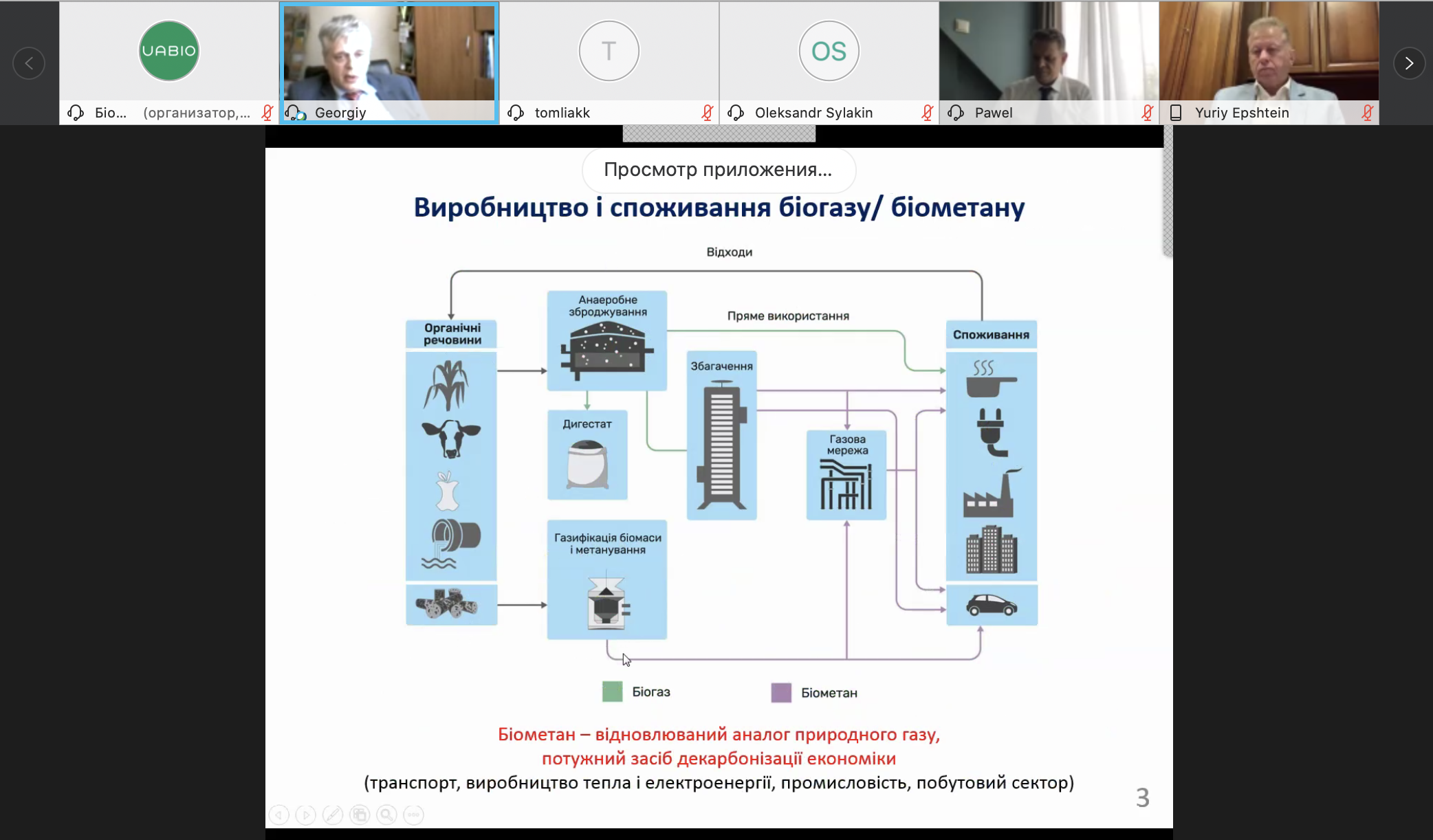
Презентації спікерів:
- Presentation “EBRD and GEF Programme “Ukraine: Sustainable Innovations in Bioenergy Value Chains”. Kyrylo Tomliak – EBRD Program Manager (in Ukrainian).
- Proposals for legislative support of biomethane production and consumption. Yurii Shafarenko – Deputy Chairman of the State Agency on Energy Efficiency and Energy Saving of Ukraine (in Ukrainian).
- Potential and output of biomethane production/usage in Ukraine and the world. Technical and economic aspects. Georgii Geletukha – Chairman of the Board of UABIO (in Ukrainian).
- Prospects for biomethane production in the agro-industrial complex of Ukraine. Oleksandr Dombrovskyi – Chairman of the Board of Civic Union Global 100 RE Ukraine, president of the MHP Eco Energy (in Ukrainian).
- Hydrogen production from biomass. Yurii Epstein – Director of Accord LLC (in Ukrainian).
- New energy strategy. Why hydrogen, why right now? Oleksandr Repkin – President of Energy Association «Ukrainian Hydrogen Council» (in Ukrainian).
